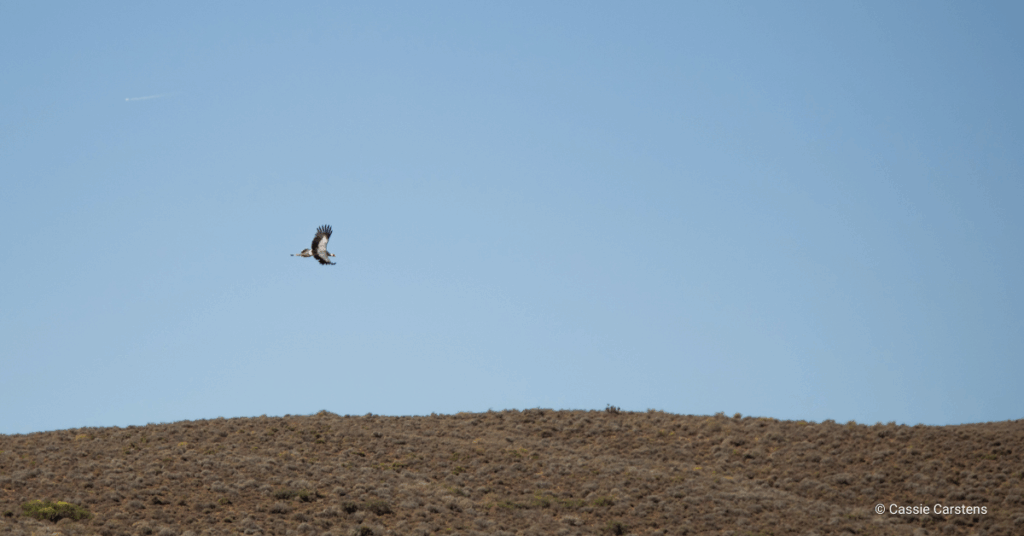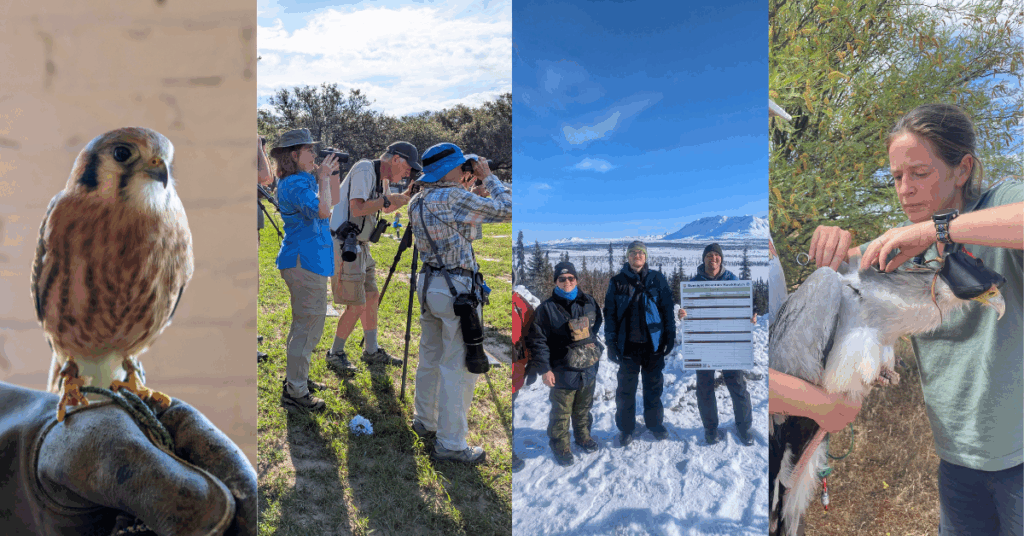Across the western United States, researchers are working to understand what is causing declining populations of the Greater Sage-grouse, including whether predation is playing a role. Over the last three years, we’ve studied the impact that one predator in particular—the Golden Eagle—is having on this once widely distributed and abundant native upland gamebird.
So what is contributing to this species’ decline? For starters, their habitat has practically disappeared. Sage-grouse are only found in sagebrush habitat and need large expanses of continuous, quality sagebrush. Historical Sage-grouse habitat has shrunk from around 1.2 million km2 to around 668,000 km2 today (Schroeder et al. 2004). Fire, grazing, agriculture, invasive species, encroachment of trees, and urbanization have all impacted sagebrush landscapes. The multiple threats facing Sage-grouse make it much harder for wildlife managers to restore populations and sagebrush habitats.
Could Predators Be Contributing to Greater Sage-grouse Declines?
Male Greater Sage-grouse are well-known for their showy courtship displays on communal leks, or sites where males establish and defend territories and perform elaborate strutting displays for females. Lek sites are typically bare and semi-open areas surrounded by sagebrush they use for cover, nesting, and foraging. Flashy courtship displays that can attract predators, and the open areas they gather make Sage-grouse particularly vulnerable when displaying at leks.
Golden Eagles are year-round residents in the sagebrush ecosystem and are one of the predators of adult Greater Sage-grouse. Although it may be rare to witness Golden Eagle predation of lekking Sage-grouse, there are many accounts of how the presence of Golden Eagles affects Sage-grouse behavior at leks. For example, Sage-grouse hide or flush and cease lek activity when a Golden Eagle shows up at the lek. We also know that Sage-grouse begin strutting before sunrise and generally retreat into the sagebrush cover within a few hours after sunrise before avian predators are more likely to be active. While Golden Eagle predation is unlikely to play a significant role in the overall decline of Sage-grouse, few observational studies have looked into Golden Eagle predation of Sage-grouse or Sage-grouse behavioral responses to Golden Eagles during the lek period.

Our Research
To learn more about Golden Eagle predation of Sage-grouse, I pursued this research for my Master’s work at Utah State University alongside HWI. We conducted surveys for Sage-grouse, Golden Eagles, and other predators at leks near Vernal, Utah during spring 2022-2024. We counted Sage-grouse at the leks, documented all predator sightings, and recorded Sage-grouse behavioral responses to different predator species. Additionally, we conducted predator surveys in the afternoon during peak Golden Eagle flying times based on existing Utah Golden Eagle transmitter data (HWI and Department of Defense, unpublished data). We will compare the frequency of Golden Eagle detections during the afternoon point counts to Golden Eagle detections during the morning lek surveys to determine whether eagles are detected more frequently during the lek period than peak flying and hunting hours.
Although Golden Eagles are one of the many predators of adult Sage-grouse, the magnitude and extent of their impact is unclear. At HWI we are especially interested in researching Greater Sage-grouse because, similarly to Sage-grouse, Golden Eagles are considered a Utah Species of Greatest Conservation Need (Utah Wildlife Action Plan Joint Team 2015). Habitat loss and fragmentation that impacts Sage-grouse populations, also negatively impacts Golden Eagles. Improvements to habitat that benefit Sage-grouse also benefit many other species in the sagebrush biome, including Golden Eagles and their primary prey, rabbits. Studying this relationship more deeply could help guide management actions for both species.

Studying species interactions is a challenging endeavor. Our study utilized non-invasive methods on a smaller scale. While my data analysis will provide further insight into Sage-grouse responses to predators at the lek, further long-term research is needed to determine whether Golden Eagles are impacting Sage-grouse populations. This type of study would require putting transmitters on hundreds of Sage-grouse and tracking population metrics over many years.
Beginning fieldwork in the early spring brought some challenges to the research. In addition to the cold temperatures and strong winds, the record winter snowfall in 2023 made accessing the leks difficult for us and the Sage-grouse who had to find areas to strut where the sagebrush wasn’t entirely covered by snow.
One of the highlights of the project was installing motion-activated cameras into three Golden Eagle nests to examine diet in the study area. Only one nest successfully fledged a chick, which is wearing a GPS transmitter backpack and still alive today! The camera data was exciting to review and didn’t show any Sage-grouse delivered to the nests. We found that 74% of prey items seen on camera were mammals. During three years of research, we only observed one successful Golden Eagle predation of a Sage-grouse, despite finding other evidence of Golden Eagles eating Sage-grouse, such as a fresh pellet with a Sage-grouse foot in it!

We would like to thank Utah State University, the Vernal Office of the Bureau of Land Management, and Utah Division of Wildlife Resources for their support of this research.
Literature Cited
Schroeder, M. A., Aldridge, C. L., Apa, A. D., Bohne, J. R., Braun, C. E., Bunnell, S. D., Connelly, J. W., Deibert, P. A., Gardner, S. C., Hilliard, M. A., Kobriger, G. D., McAdam, S. M.,
McCarthy, C. W., Mitchel, D. L., Rickerson, E. V., & Stiver, S. J. (2004). Distribution of Sage-grouse in North America. The Condor, 106, 363-376.
This blog was written by HWI’s Field Biologist, Tori Thorpe. You can learn more about Tori here.



